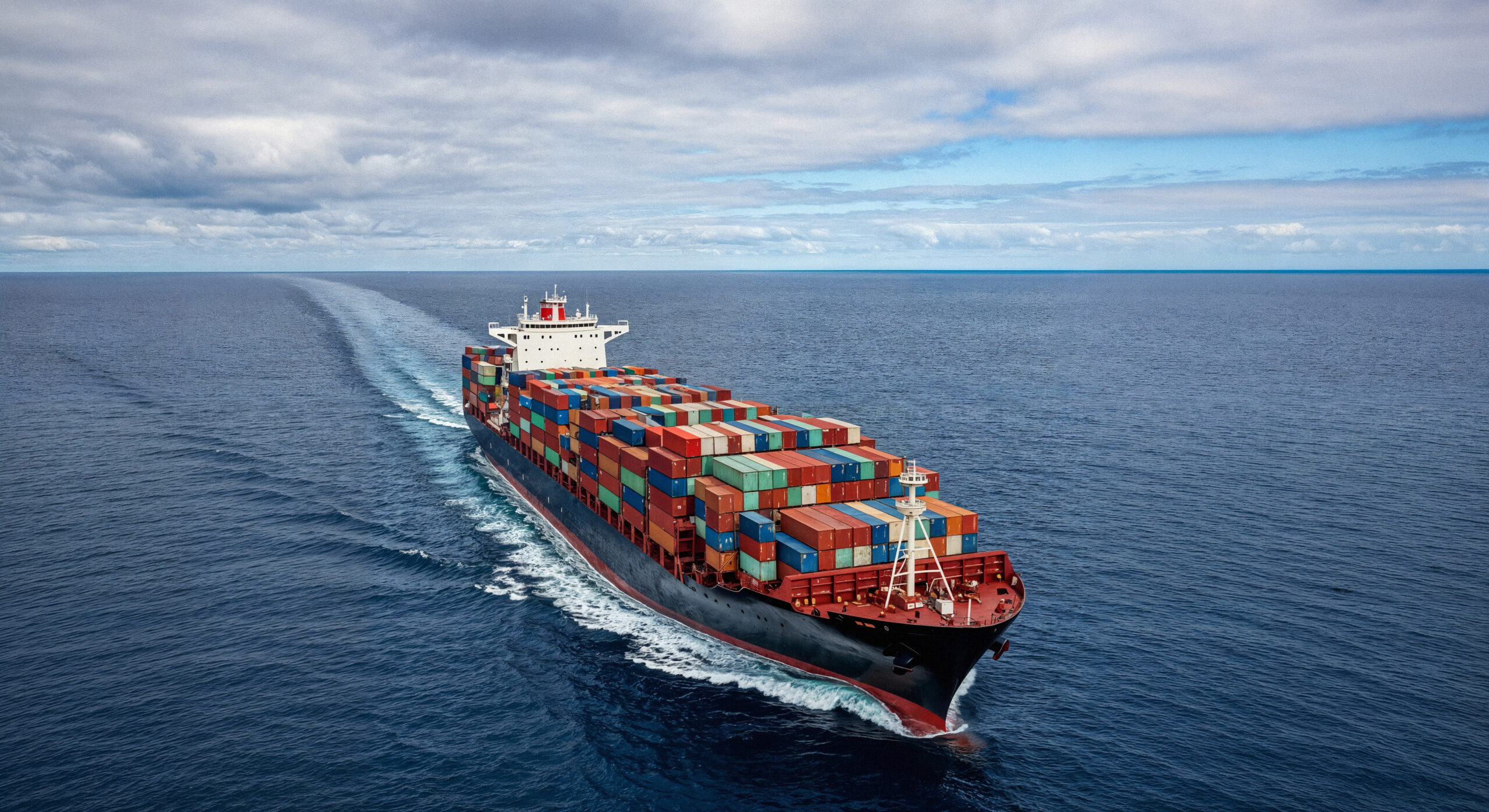What Was the Merchant Shipping Act, 1958?
The Merchant Shipping Bill, 2024, is a new version of the Merchant Shipping Act of 1958. The older version served as India’s cornerstone legislation governing the shipping sector for over six decades. Enacted in a post-independence context, it aimed to regulate aspects such as vessel registration, crew safety, pollution control, and the overall operation of ships in Indian waters. While it was instrumental in laying the foundation for India’s maritime framework, it increasingly lagged behind in addressing the complexities of modern shipping.
With the rapid expansion of offshore exploration, autonomous vessels, digital trading systems, and new international standards, the Act became outdated. Its fragmented approach, limited vessel definitions, and lack of digital adaptability made it less effective in governing a 21st-century maritime ecosystem.
What Has Changed in the Merchant Shipping Bill, 2024?
- Universal Vessel Registration: All vessels must now register, regardless of propulsion or tonnage. Earlier, non-mechanical or small coastal vessels were exempt.
- Expanded Definition of Vessels: Now includes submersibles, hydrofoils, mobile offshore drilling units, and non-displacement crafts.
- Liberalized Ownership: Allows Overseas Citizens of India (OCIs), NRIs, and LLPs to own vessels. Earlier, only Indian citizens or companies were eligible.
- Chartered Vessel Registration (BBCD): Permits Indian registration of foreign-chartered ships intended for future ownership.
- Temporary Registration for Ship Recycling: Unregistered foreign vessels destined for recycling in India can now be registered temporarily.
- Updated Authorities: Renames the DG Shipping as Director-General of Marine Administration, while retaining boards like the National Shipping Board.
- Dedicated Maritime Security Body: Authorizes the government to set up a new security regulator for ports and vessels.
- Training Institute Regulation: Makes it mandatory for maritime training institutes to be approved by the DG.
- Seafarer Contracts & Social Security: Expands contract authority to ship owners and agencies; introduces social security for seafarers.
- Pollution Compliance: Mandates a pollution prevention certificate for all vessels, previously limited to large tankers.
- Criminal vs Civil Offences: Decriminalizes minor offences; introduces new penalties for illegal agencies and pollution.
- Digital Framework: Enables e-registration, e-certification, and risk-based digital inspections.
- Global Convention Compliance: Aligns with MARPOL, SOLAS, MLC, and Wreck Removal Convention.
How It Aims to Improve the Shipping Industry
The Bill lays the groundwork for a more competitive, sustainable, and transparent maritime industry. It is tailored to support India’s goal of expanding its shipping fleet and global trade presence. By modernizing ship registration, simplifying ownership laws, and digitizing compliance, the legislation significantly improves the ease of doing business in the maritime sector.
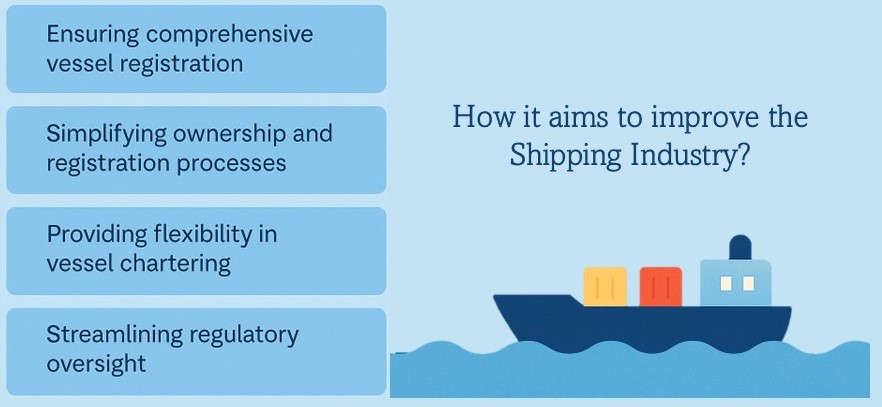
It strengthens the quality of Indian maritime training, enhancing workforce readiness and seafarer global competitiveness. The universal pollution compliance measure improves environmental responsibility across vessels of all sizes, and the inclusion of modern vessel types under regulation ensures safety and accountability in newer operational domains.
By embedding international conventions into Indian law, the Bill makes India’s maritime sector more predictable, legally aligned with global expectations, and attractive to international partners and insurers.
How Will It Help or Change the Perspective for Various Stakeholders?
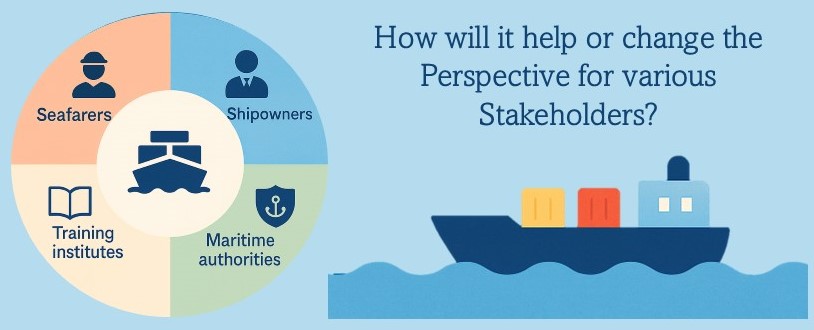
- Ship Owners & Operators: Greater flexibility and streamlined procedures like BBCD and temporary recycling registration make scaling easier.
- OCIs, NRIs, Investors: Broader ownership eligibility lowers investment barriers and fosters global participation.
- Seafarers and Agencies: Stronger contract provisions and social security boost welfare and align with international labour standards.
- Training Institutions: Must seek approvals but benefit from an upgraded quality framework.
- Environmental Regulators & NGOs: Universal pollution mandates enhance oversight and green compliance.
- Security Authorities: Now empowered to set up a dedicated regulator for port and vessel security.
- State & Central Governments: Gain a modern framework that improves compliance, trade, safety, and branding of India as a maritime hub.
What Further Improvements Could Have Been Done?
While the Merchant Shipping Bill, 2024 is ambitious and comprehensive, there are areas where it could have gone further. One significant omission is the lack of a cybersecurity framework. In an era where ships and ports are frequently targeted by cyberattacks, the absence of mandated cyber protocols is a major oversight. There are also no guidelines for maritime cyber risk assessments, crew cybersecurity training, or secure IT infrastructure for digital ship systems.
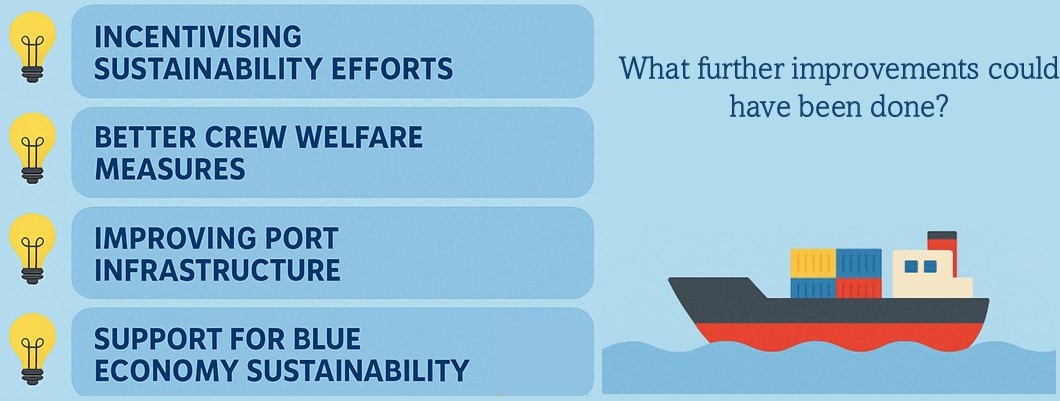
India is yet to fully recognize electronic bills of lading (eBLs) under a legal framework like MLETR (Model Law on Electronic Transferable Records). Countries like the UK and Singapore are already implementing laws that legally equate digital shipping documents with paper-based ones. This limits India’s readiness for global digital trade.
Additionally, the Bill does not contain Admiralty-style enforcement provisions such as vessel arrest rights, which exist under the UK Merchant Shipping Act, 1995. Nor does it empower Indian courts adequately for dispute resolution or liability enforcement, especially for foreign-flagged vessels.
Finally, India still operates under multiple maritime legislations for inland waterways, fisheries, and coasting trade. A unified maritime code could simplify this complexity.
What Are the Gaps and Areas for Improvement Even After Implementing These Changes?
Despite its strengths, the Bill leaves several issues unresolved. For instance, it lacks any provisions regarding crew mental health, occupational hazard management, or crisis management during pandemics and emergencies. These were critical issues highlighted during the COVID-19 crisis but remain unaddressed.
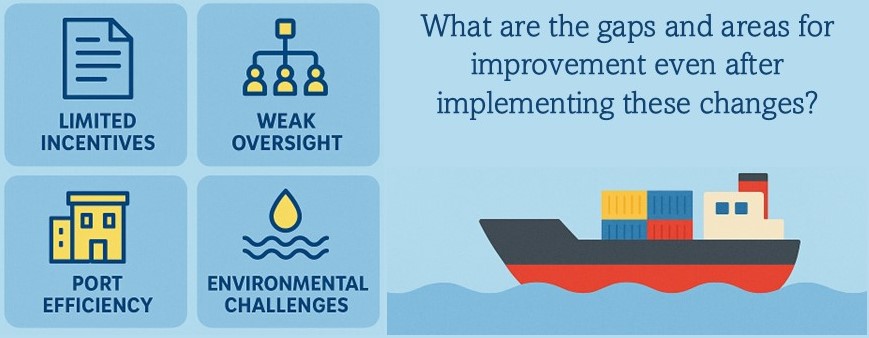
Another concern is the absence of built-in mechanisms to automatically incorporate future amendments to global conventions like MARPOL or SOLAS into Indian law. These risks creating regulatory delays and compliance gaps.
There is also limited clarity on vessel-owner liability for third-party damages, coastal infrastructure harm, or environmental degradation. Similarly, while digital enforcement is a key part of the Bill, the penalties for non-compliance with digital obligations remain weak or undefined.
Lastly, the Bill does not address the integration of India’s inland waterways into the broader maritime economy, a key aspect of multimodal logistics development.
Conclusion
The Merchant Shipping Bill, 2024 is a landmark shift in India’s maritime regulatory landscape. It reflects bold steps toward digitization, inclusivity, safety, and sustainability. It positions India as a serious contender in the global shipping sector and aligns domestic laws with the best international practices.
However, maritime is an ever-evolving space. For India to maintain its momentum and lead, it must continuously refine its legislative framework. This includes integrating cybersecurity protocols, adopting transferable electronic documents, consolidating maritime laws, and empowering maritime courts.
In its current form, the Bill is a solid foundation. With thoughtful amendments and a future-focused approach, it could become the gold standard for maritime governance in the Global South.
Reference: PRS Legislative Research
Also Read: Ports Bill 2025: A Historic Shift Towards Modern Maritime Governance
